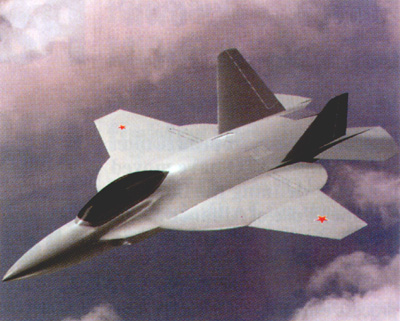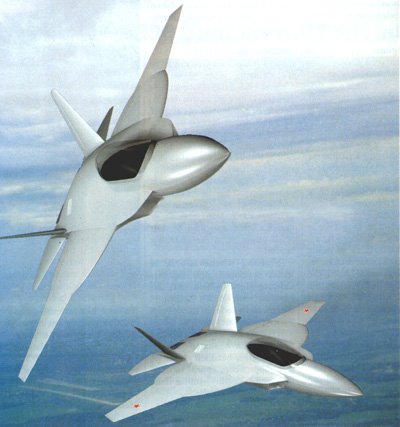 Development of Russia's LFI (logkiy frontovoi istrebitel)
lightweight tactical fighter has been dramatically accelerated after the Russian Air Force
decided it's priorities for the next 10 years.
Development of Russia's LFI (logkiy frontovoi istrebitel)
lightweight tactical fighter has been dramatically accelerated after the Russian Air Force
decided it's priorities for the next 10 years.
The I-2000 (Istrebitel [fighter] 2000), is due to become operational in 2005 as Russia's basic front-line fighter. It is also likely to become the leading export product of the Russian aircraft industry. Available information on the I-2000 indicates that it will be closely comparable to the US Joint Strike Fighter,operating in both air-to-air and air-to-surface roles.
The aircraft comes from a long line of Mikoyan lightweight fighters, such as the MiG-15 and MiG-21. It is about the same size as the MiG-21 (shorter by 1.3m but wider by 4.5m), but noticeable smaller than its immediate predecessor, the MiG-29. Take-off weight is estimated at around 12 tonnes; maximum take-off weight at about 16 tonnes.
The design requirements for I-2000 call for reduced radar and infrared visibility and very high manoeuvrability, as well as short take-off and landing. The aircraft will have a blended fuselage/centre wing and a thick wing centre-section, with curved leading and trailing edges. The unusual aerodynamic configuration and powerful thrust-vectoring engines should provide excellent agility. Take-off and landing runs are short thanks to a specially designed landing gear that permits approaches at high angles of attack.
According to official sources, single and twin-engined variants of the LFI are under consideration. The graphics show a twin- engined variant with an all-new power plant. No engines of the required thrust currently exist in Russia.

The first design of a very light new-generation fighter was prepared by Mikoyan in the early 1980s, when design work also began on the heavy fighter, the MFI (sometimes known as the 1-42). The result was 'Product 33' powered by a single RD-33 engine from the MiG-29. It was of conventional design, appearing similar to the US Lockheed Martin F-16.
Although work on Product 33 became well advanced, it was not ordered due to the air force's reorientation towards multi-role aircraft - the lightweight Product 33 could be used for close air combat only. The basic Product 33 design is being offered by Mikoyan to China as the FC-1 fighter.
The only competition within Russia for the I-2000 is the S-54, developed by Sukhoi from an advanced trainer design of the early 1990s.
The S-54 is essentially a smaller, single-engined Su-35, with a more conventional layout than the I-2000. The status of the S-54 is unknown, but is thought to be in the initial stages of development. Having no real Russian Air Force support, the S-54 is intended for export as a complement to the heavy Su-27 and Su-30 aircraft sold to China and India.
It has been decided that the heavy fifth-generation MFI will not enter serial production. It will, however, begin flight tests this August as a technology demonstrator. Mikhail Korzhuyev, recently appointed Mikoyan's general director, said that flights of the MFI are now a matter of honour for the company.
The aircraft has been ready for flight tests for about five years, but grounded for lack of cash. An extensive upgrade programme for the MiG-29 is to continue in parallel with development work on the I-2000."
Source: Jane's Defence Weekly, vol.29
